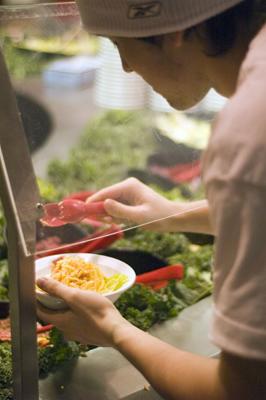
Daniel Joe
The first of February.
Not too late to have forgotten a New Year’s resolution to lose weight. Not too early to start thinking about Spring Break vacations that, more than likely, include slipping into a bathing suit.
Sandwiched, pun intended, between the beginning of a new year and a cruise to the Yucatan, February is crunch time for students looking to shed unwanted pounds and tone bodies.
The obvious place to initiate weight loss is in eating habits, and for many campus-bound students, shifts in diet start with campus dining halls.
“I eat at Fountain Dining Hall twice a day for the most part because I don’t have a car to go off campus,” Corey Green, a freshman in meteorology, said.
Twice a day means more than half of Green’s daily nutritional intake is based on what is made available to him and other students by University Dining.
University Dining Dietitian Lisa Eberhart said Dining is sensitive to the nutritional needs of its customers.
“Basically, what University Dining tries to do is to give students a healthy option at every meal,” Eberhart said. “We offer at least one vegetarian and one vegan dish, and fruits and vegetables at every meal.”
Students said they were grateful for the attention given to incorporating healthy foods into dining hall menus.
“Fountain [dining hall] has the best supply of healthy foods, so it’s usually where I eat,” Kyle Flack, a sophomore in chemistry, said.
Green said he notices a difference in his level of energy and awareness when he eats more nutritious foods, specifically fruits, which are abundant in all dining halls.
“Especially when you have classes from nine in the morning until five in the afternoon, you can tell a difference from what you have eaten,” Green said.
Despite its efforts, University Dining, Eberhart said, must meet certain demands from students, which sometimes means promoting unhealthy diets.
“Many, many students have been raised on fast food so we have to always have that fast food-looking option,” she said.
Eberhart said while the University does provide students with fast food in the form of Taco Bell, Lil’ Dino’s and Chick-fil-A, it is one of the few universities to provide students with nutritional breakdown of the foods served on campus.
“[More than] 90 percent of our food has a nutritional analysis on the University Dining Web site,” Eberhart said. “Students can also look up the analysis on fast food they are eating.”
Flack, who divides his daily meals between Fountain Dining Hall and the Atrium, said he was aware of the nutritional information made available by Dining.
Eberhart said much of her efforts go into passive nutrition education.
“Our plan is called ‘Do you know what you are eating?'” Eberhart, who works closely with Student Health Promotion, said. “Students can see a dietitian for free and there is a function on the Dining Web site where students can ask a dietitian questions.”
Eberhart, who also serves as a dietitian for all of the University’s athletic teams, said she meets with several students every day she works and often spends her evenings replying to questions directed to her from the Web site.
“I see people pretty much for weight loss, weight gain, high cholesterol and high blood pressure,” Eberhart, who, as a diabetes educator, also consults students who have the metabolic illness, said.
Green and Flack said they were thankful for the University’s attention to their well-beings, but said the dining halls could stand to mix it up every now and then.
“It gets old, even though it’s healthy, they don’t change it up much,” Flack said. “A larger selection would be a nice — a certain vegetable once or twice a week would be nice rather than four times a week like it is so often.”